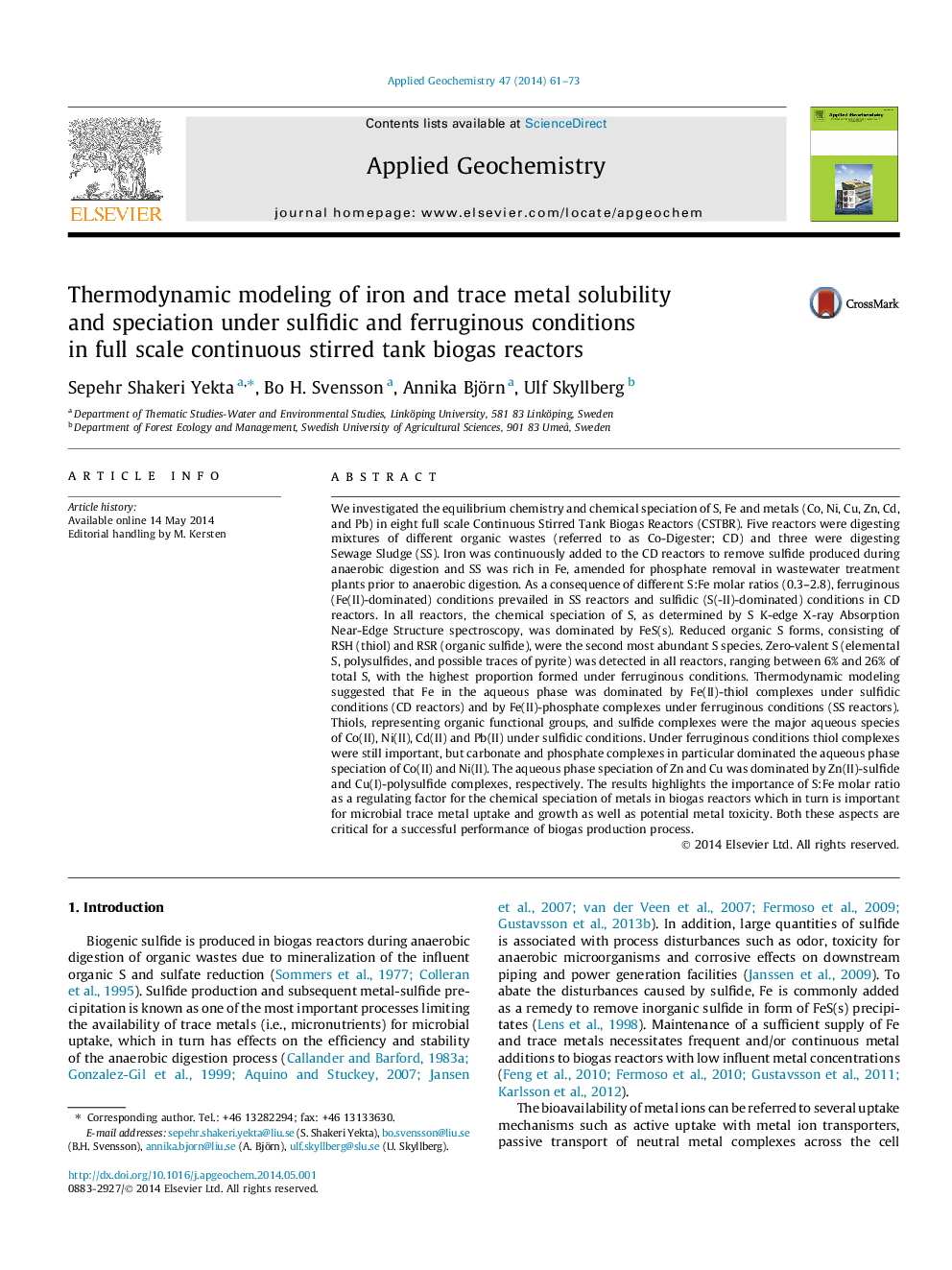| کد مقاله | کد نشریه | سال انتشار | مقاله انگلیسی | نسخه تمام متن |
|---|---|---|---|---|
| 4435739 | 1620244 | 2014 | 13 صفحه PDF | دانلود رایگان |
• Iron, sulfur, and trace metal speciation was studied in full scale biogas reactors.
• Speciation of sulfur was dominated by FeS, thiol/organic sulfide, and zero-valent S.
• The S:Fe molar ratio controls aqueous sulfide and indirectly trace metal speciation.
• Zero-valent S formation was enhanced under ferruginous conditions.
• Sulfide, polysulfide and organic ligands were shown to control metal solubility.
We investigated the equilibrium chemistry and chemical speciation of S, Fe and metals (Co, Ni, Cu, Zn, Cd, and Pb) in eight full scale Continuous Stirred Tank Biogas Reactors (CSTBR). Five reactors were digesting mixtures of different organic wastes (referred to as Co-Digester; CD) and three were digesting Sewage Sludge (SS). Iron was continuously added to the CD reactors to remove sulfide produced during anaerobic digestion and SS was rich in Fe, amended for phosphate removal in wastewater treatment plants prior to anaerobic digestion. As a consequence of different S:Fe molar ratios (0.3–2.8), ferruginous (Fe(II)-dominated) conditions prevailed in SS reactors and sulfidic (S(-II)-dominated) conditions in CD reactors. In all reactors, the chemical speciation of S, as determined by S K-edge X-ray Absorption Near-Edge Structure spectroscopy, was dominated by FeS(s). Reduced organic S forms, consisting of RSH (thiol) and RSR (organic sulfide), were the second most abundant S species. Zero-valent S (elemental S, polysulfides, and possible traces of pyrite) was detected in all reactors, ranging between 6% and 26% of total S, with the highest proportion formed under ferruginous conditions. Thermodynamic modeling suggested that Fe in the aqueous phase was dominated by Fe(II)-thiol complexes under sulfidic conditions (CD reactors) and by Fe(II)-phosphate complexes under ferruginous conditions (SS reactors). Thiols, representing organic functional groups, and sulfide complexes were the major aqueous species of Co(II), Ni(II), Cd(II) and Pb(II) under sulfidic conditions. Under ferruginous conditions thiol complexes were still important, but carbonate and phosphate complexes in particular dominated the aqueous phase speciation of Co(II) and Ni(II). The aqueous phase speciation of Zn and Cu was dominated by Zn(II)-sulfide and Cu(I)-polysulfide complexes, respectively. The results highlights the importance of S:Fe molar ratio as a regulating factor for the chemical speciation of metals in biogas reactors which in turn is important for microbial trace metal uptake and growth as well as potential metal toxicity. Both these aspects are critical for a successful performance of biogas production process.
Journal: Applied Geochemistry - Volume 47, August 2014, Pages 61–73
